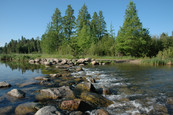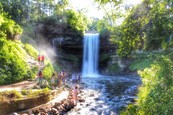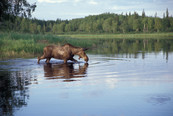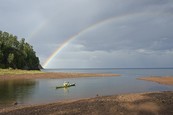Sprigs of scientific discoveries for natural resources managers
|
|
|
Volume 3 - April 2020
Water Resources
As we notice winter melting away and spring trickling in, snow and ice slowly transform into flowing rivers and thawed lakes. In this issue of the Reader, we offer an array of research related to water resources in Minnesota--from ecosystem services of large lakes and fisheries to community engagement in urban restoration. There is undoubtedly much more to cover in this field than the four articles presented here. So, check out these additional water-related resources: The Minnesota Water Research Digital Library showcases a breadth of additional research compiled by the Minnesota Department of Agriculture; this recent report on the future of drinking water in Minnesota; this article by the Minnesota DNR Lakes Unit, which won the North American Lake Management Society 2019 Best Paper Award in the journal Lake and Reservoir Management; and an adorable water conservation steward paving the way in Arkansas.
The Minnesota Research Reader is a collaboration between the Minnesota Department of Natural Resources and the USDA Forest Service that is intended to provide a quick look at emerging research relevant to our work in the State of Minnesota. We hope you enjoy getting your feet wet in this springtime issue of the Reader!

Climate change is altering glacial lake fisheries in the United States, presenting a complex challenge for fisheries managers. This article (co-authored by Peter Jacobson from the Minnesota DNR) provides a regional perspective to guide management of heterogeneous and yet interdependent fishery resources in glacial lakes of the upper Midwest. The main objective was to promote the adaptation of inland glacial lakes fisheries management to climate change by outlining processes that support regional plans.
Management Implications:
- One of the major challenges facing managers over the next several years will be to help Minnesota’s water resources adapt to a changing climate.
- This study's approach helps specify strategies for moving from regional prioritization to on-the-ground action, and provides guidance on the implementation of management plans, given resource limitations and potential stakeholder conflict.
- Integrating ecological, social and economic data with climate change vulnerability assessments can be useful in generating “lake-priority levels,” to help identify where to focus actions to support system resilience.
|

According to this recent study, people of color, and those of lower income brackets, are frequently underrepresented in water‐related programming or decision‐making, although they are often disproportionately affected by water problems. This study included interviews of community members in the urbanized Minnehaha Creek Watershed to understand real or perceived barriers to community members engaging in water planning, protection and restoration. This work points to opportunities to increase partnership and expand engagement in water planning, protection and restoration.
Management Implications:
- Re-envisioning community engagement to a community-driven approach may better support and engage underrepresented communities. Check out this hot off the press publication describing additional approaches in advancing water equity demands.
- Engaging all stakeholders, including communities of color, early in water planning, protection and restoration activities will allow plans to better represent all community concerns.
- Drawing linkages between water and other issues that have strong community engagement, such as health and education, may resonate with more stakeholders and broaden participation.
|

Blooms of harmful Cyanobacteria have adverse effects on water quality, survival of aquatic animals, and human health in lakes, reservoirs and coastal oceans. Within a eutrophic lake or reservoir, day‐to‐day fluctuations of Cyanobacteria can be highly variable, affecting daily human use of the water supply for drinking, recreation or harvesting fish. This study compares the roles of equilibria vs. environmental variability for Cyanobacteria dynamics in surface waters.
Management Implications:
- Algae blooms can turn water green and rank and can contribute to fish kills and, at times, produce toxins that pose a health risk to people and animals.
- Harmful Algal Blooms (HABs) are on the rise in Minnesota lakes, streams and wetlands and may be triggered by urban and agricultural runoff as well as climate change.
- Within a eutrophic lake or reservoir, day‐to‐day fluctuations of Cyanobacteria can be highly variable and these short‐term fluctuations affect daily human use of the water supply for drinking, recreation or harvesting fish.
- The results demonstrate the value of long-term, high-frequency sampling.
|

Fresh water is distributed unevenly across the globe. The Earth’s 21 largest lakes hold approximately two-thirds of all liquid surface fresh water and occupy diverse ecological and social settings. This paper identifies seven ecosystem services across most or all of these large lakes, including fisheries, transportation, water treatment, irrigation, recreation and tourism, thermopower capacity and hydropower capacity. This study provides insights to many of the benefits from these complex systems and an examination of underlying patterns of ecosystem services and large lakes.
Management Implications:
- Lake Superior is the largest freshwater lake by area in the world and has global importance with its valuable freshwater ecosystem services.
- Water use in the Laurentian Great Lakes is generally legally restricted for use only the Great Lakes watershed. This is an important aspect to Lake Superior's ecosystem services, considering the increasing conversations worldwide surrounding long-distant transport of abundant freshwater resources.
- Recreation, tourism, fisheries and power generation are all vital to Minnesota. Understanding both ecological and social impacts will be important in the long-term sustainability of these significant ecosystem services.
|
|
|
|
Photo credits from top to bottom: Minnesota Department of Natural Resources, Minnesota Department of Natural Resources, US Fish and Wildlife, Minnesota Department of Natural Resources
|
|
Please sign up for future editions and feel free to share with others!
Subscribe to the newsletter.
|
|